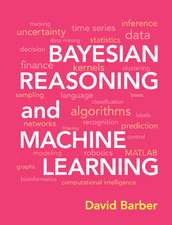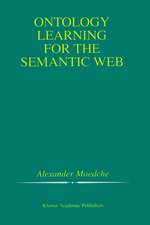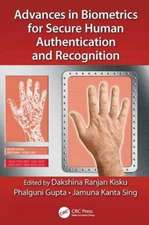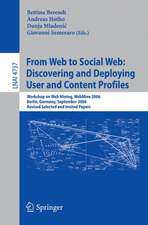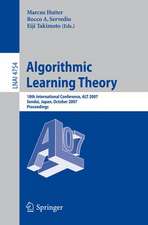Ensemble Machine Learning: Methods and Applications
Editat de Cha Zhang, Yunqian Maen Limba Engleză Paperback – 12 apr 2014
Responding to a shortage of literature dedicated to the topic, this volume offers comprehensive coverage of state-of-the-art ensemble learning techniques, including the random forest skeleton tracking algorithm in the Xbox Kinect sensor, which bypasses the need for game controllers. At once a solid theoretical study and a practical guide, the volume is a windfall for researchers and practitioners alike.
| Toate formatele și edițiile | Preț | Express |
|---|---|---|
| Paperback (1) | 1444.52 lei 6-8 săpt. | |
| Springer – 12 apr 2014 | 1444.52 lei 6-8 săpt. | |
| Hardback (1) | 1450.95 lei 6-8 săpt. | |
| Springer – 17 feb 2012 | 1450.95 lei 6-8 săpt. |
Preț: 1444.52 lei
Preț vechi: 1805.64 lei
-20% Nou
Puncte Express: 2167
Preț estimativ în valută:
276.45€ • 287.55$ • 228.22£
276.45€ • 287.55$ • 228.22£
Carte tipărită la comandă
Livrare economică 14-28 aprilie
Preluare comenzi: 021 569.72.76
Specificații
ISBN-13: 9781489988171
ISBN-10: 1489988173
Pagini: 340
Ilustrații: VIII, 332 p.
Dimensiuni: 155 x 235 x 18 mm
Greutate: 0.48 kg
Ediția:2012
Editura: Springer
Colecția Springer
Locul publicării:New York, NY, United States
ISBN-10: 1489988173
Pagini: 340
Ilustrații: VIII, 332 p.
Dimensiuni: 155 x 235 x 18 mm
Greutate: 0.48 kg
Ediția:2012
Editura: Springer
Colecția Springer
Locul publicării:New York, NY, United States
Public țintă
ResearchCuprins
Introduction of Ensemble Learning.- Boosting Algorithms: Theory, Methods and Applications.- On Boosting Nonparametric Learners.- Super Learning.- Random Forest.- Ensemble Learning by Negative Correlation Learning.- Ensemble Nystrom Method.- Object Detection.- Ensemble Learning for Activity Recognition.- Ensemble Learning in Medical Applications.- Random Forest for Bioinformatics.
Recenzii
From the reviews:
“The book itself is written by an ensemble of experts. Each of the 11 chapters is written by one or more authors, and each approaches the subject from a different direction. … This is an excellent book for someone who has already learned the basic machine learning tools. It would work well as a textbook or resource for a second course on machine learning. The algorithms are clearly presented in pseudocode form, and each chapter has its own references (about 50 on average).” (D. L. Chester, ACM Computing Reviews, July, 2012)
“The book itself is written by an ensemble of experts. Each of the 11 chapters is written by one or more authors, and each approaches the subject from a different direction. … This is an excellent book for someone who has already learned the basic machine learning tools. It would work well as a textbook or resource for a second course on machine learning. The algorithms are clearly presented in pseudocode form, and each chapter has its own references (about 50 on average).” (D. L. Chester, ACM Computing Reviews, July, 2012)
Notă biografică
Dr. Zhang works for Microsoft. Dr. Ma works for Honeywell.
Textul de pe ultima copertă
It is common wisdom that gathering a variety of views and inputs improves the process of decision making, and, indeed, underpins a democratic society. Dubbed “ensemble learning” by researchers in computational intelligence and machine learning, it is known to improve a decision system’s robustness and accuracy. Now, fresh developments are allowing researchers to unleash the power of ensemble learning in an increasing range of real-world applications. Ensemble learning algorithms such as “boosting” and “random forest” facilitate solutions to key computational issues such as face detection and are now being applied in areas as diverse as object trackingand bioinformatics.
Responding to a shortage of literature dedicated to the topic, this volume offers comprehensive coverage of state-of-the-art ensemble learning techniques, including various contributions from researchers in leading industrial research labs. At once a solid theoretical study and a practical guide, the volume is a windfall for researchers and practitioners alike.
Responding to a shortage of literature dedicated to the topic, this volume offers comprehensive coverage of state-of-the-art ensemble learning techniques, including various contributions from researchers in leading industrial research labs. At once a solid theoretical study and a practical guide, the volume is a windfall for researchers and practitioners alike.
Caracteristici
Covers all existing methods developed for ensemble learning Presents overview and in-depth knowledge about ensemble learning Discusses the pros and cons of various ensemble learning methods Demonstrate how ensemble learning can be used with real world applications


